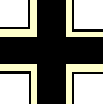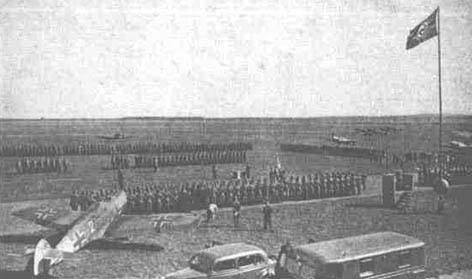Spain


Teniente Esteban Ibarreche Arriaga
Spain


Teniente Esteban Ibarreche Arriaga
Ibarreche took part in the Spanish Civil War and he joined the Nationalist Army at the end of the Biscay campaign.
He completed his pilot training in January 1938 from where he was posted direct to Group 2-G-3. This unit was equipped with the Fiat CR.32.
During a second sortie of the day on 19 June, ten Fiats of 2-G-3 took off at 18:00 led by capitán Ángel Salas, to escort Ju 52/3ms bombing La Puebla de Valverde. They encountered a formation of 18 Chatos, which they chased as far as Alcublas, where nine Ratas joined the fray. Capitán Salas dived over the Chatos to attack, but was unable to fire his guns because a leak had emptied his compressed air bottle. Despite this, he continued to make dummy attacks, being hit five times by the Ratas, one bullet puncturing the coolant radiator. Teniente Julio Salvador (CO 1-E-3) enjoyed better luck, bouncing two Chatos from above near La Puebla, one of which exploded in the air, the other following in flames. It seems that these come from the 3a Escuadrilla and both pilots survived with wounds. Salvador then had to retire with an overheating engine. Teniente Miguel García Pardo (2-E-3) effectively removed a Rata from the tail of alférez Arístides García López Rengel’s (1-E-3) Fiat by shooting it down. Teniente de Hemricourt (2-E-3) downed a Chato near Alcublas, then a Rata to the north of Villar del Arzobispo, and saw a Chato turn somersault as it attempted to land at its aerodrome. Teniente Ibarreche fired at a Chato close to the ground, and this separated from the rest of the formation and fell near to Hiruerela. Alférez Joaquín Ansaldo Vejarano (2-E-3) had to return to base when an engine cowling parted company from his Fiat.
No CR.32s were lost in this combat.
In the morning on 2 September, a formation of nine R-Zs, escorted by a similar number of I-15s, were attacked by 18 Spanish-flown CR.32s near Monterrubio de la Serena as they returned from a bombing mission. Minutes later nine SBs from 4a Escuadrilla of Grupo No 24, escorted at a distance by 11 I-16s Type 10, hove into view too. The CR.32s concentrated on the Tupolev bombers and their monoplane fighter escorts. In a single attack, capitán Ángel Salas (2-G-3) destroyed three Katiuskas, and then capped this by damaging the I-16 Type 10 flown by the leader of the 1a Escuadrilla Grupo de Moscas No 21 that was escorting them. This pilot, teniente José Redondo Martín (the son of the former mayor of Madrid, Cayetano Redondo Aceña), took to his parachute and was guarded by Salas until he had almost reached the ground. Salas, before flying away, raised an arm in the Fascist salute, and Redondo (I-16 ‘CM-214’) responded in a similar manner with a clenched fist.
Salas noted in his logbook:
“After 50 minutes on patrol I spotted nine “Martin bombers” that were a little higher than us heading in the direction of our lines. I gained height as I flew towards them, cutting off their escape route. As they returned after bombing Monterrubio, I attacked the bomber on the left in the first section, setting his left engine on fire. I then hit the left engine of the leader’s aircraft, setting it on fire too, and the third bomber suffered the same fate. Then I fired straight up at the leader of the second flight, and his aircraft started trailing white smoke. It was then that I noticed some Ratas, so I attacked one. After a long fight it also started to trail smoke, and the pilot took to his parachute. He landed close to his aircraft, north of Belalcázar. During his descent I saluted him and he saluted me back.”Salas had shot down four aircraft in five minutes. A number of the crewmen from the downed bombers took to their parachutes, only to be killed as they floated down, or immediately after landing, by groundfire from Moroccan troops fighting in this area. Ricote, commander of 4a/24 and flying the SB damaged by Salas, force-landed his bomber on Almodóvar airfield after having one of his engines shot out. This event must have been well known in the Government zone, as it was reported from several sources.
“The part played by the group under your command in today's operation has filled me with pride and it gives me great satisfaction to have people under my command who know how to make the best use of prevailing circumstances. It gives me great pleasure to congratulate you personally, and the whole of your unit, to whom I hope you will convey this message.”
On 20 September, a series of daily battles began, culminating in fierce combats on 2 and 3 October. Groups 2-G-3 and 3-G-3 fought jointly in all these battles, achieving a total of twenty-five victories (17 by 2-G-3). Of these Ibarreche claimed two.
After the end of the war, he was decorated with the Cruz Militar (the Military Medal) and promoted for his services during the war. The medal was however not presented to him until the day of Our Lady of Lareto in 1941, by which time he was involved in a new war!
Ibarreche ended the Civil War with 7 biplane victories of which three were I-16s and four were I-15s. He also claimed 2 shared victories.
He later volunteered for combat in Russia and was part of the 1a Escuadrilla Azul, (Escuadrilla Expedicionaria) which was formed with 17 pilots with Salas as the Commander. Some of them were veterans of the Spanish Civil War and had a combined score of 79 aerial victories.
The unit crossed into France on 24 July 1941, later arriving in Germany in late part of the month.
They were assigned to training at the Jagdfliegerrschule 1 at Werneuchen near Berlin.
After completing their training on Bf 109 Es, the 1a Escuadrilla left for Russia on 26 September.
At first, the Spanish pilots were worried that they would arrive late to see any action, since they were kept informed of the progress of the German advance towards Moscow.

The 1a Escuadrilla received a total of 12 Bf 109 E-4s and –7s and they were assigned to JG 27, VIII FliegerKorps of LuftFlotte 2. They were known as the “15 Spanische Staffel”, and they were structured into three påatrols, with five pilots each and a staff:
Staff: CO commendante Ángel Salas and second in command commendante José Muñoz Jiménez.
1st Patrol: capitán Arístides García and tenientes Alfonso Rubial, Ángel Mendoza, Ricardo Bartolomé and Abundio Cesteros.
2nd Patrol: capitán Javier Allende and tenientes Luis Alcocer, José Lacour, Javier Busquets and Alfonso Gracia-Rodriguez.
3rd Patrol: capitán Carlos Bayo and tenientes Ibarreche, Emelio O’Connor, Manuel Kindelán and Demetrio Zorita.
The Spanish unit started to fly their first combat operations on 2 October. Escorting German bombers and reconnaissance aircraft, they operated from 12 different airfields.
The Escuadrilla arrived at Konja airfield on 12 October and on the next day, 13 October, they resumed their missions. During a reconnaissance mission over the enemy camp at Kalinin, four of them encountered three I-16s. Commendante Ángel Salas attacked one of them relentlessly and so aggressively that the Soviet pilot crashed to the ground. According to some sources, this victory was an I-18 claimed on 7 October but it seems that the Escuadrilla didn’t flew any combat missions on that date.
Later, in another encounter with several MiG-3s, capitán Carlos Bayo managed to destroy one of them.
The same day, a biplane was shot down by teniente Ibarreche.
Ibarreche claimed and SB-3 on 14 October.
The 1a Escuadrilla Azul received the orders to return to Spain on 6 January 1942.
During their time in Russia the unit flew a total of 460 missions, were engaged in 94 aerial combats and destroyed 10 enemy aircraft plus four on the ground, for the loss of 5 pilots (one KIFA, three MIA and one KIA) plus one wounded in action.
Ibarreche claimed 1 victory during his time in Russia.
Esteban Ibarreche ended the war with 7 biplane victories and a total of 9. All of the biplane victories were claimed during the Spanish Civil War.
Claims:
| Kill no. | Number | Date | Time | Type | Result | Plane type | Serial no. | Locality | Unit |
| 1938 | |||||||||
| 1 | 19/06/38 | 18:00- | 1 | I-15 | Destroyed | Fiat CR.32 | Hiruerela area | 2-G-3 | |
| 2 | 02/09/38 | morning | 1 | I-16 | Destroyed | Fiat CR.32 | Zújar area | 2-G-3 | |
| 3 | ??/??/38 | 1 | I-16 | Destroyed | Fiat CR.32 | 2-G-3 | |||
| 4 | ??/??/38 | 1 | I-16 | Destroyed | Fiat CR.32 | 2-G-3 | |||
| 5 | ??/??/38 | 1 | I-15 | Destroyed | Fiat CR.32 | 2-G-3 | |||
| 6 | ??/??/38 | 1 | I-15 | Destroyed | Fiat CR.32 | 2-G-3 | |||
| 7 | ??/??/38 | 1 | I-15 | Destroyed | Fiat CR.32 | 2-G-3 | |||
| ??/??/3? | 1 | Enemy aircraft | Shared destroyed | Fiat CR.32 | |||||
| ??/??/3? | 1 | I-15 | Shared destroyed | Fiat CR.32 | |||||
| 1941 | |||||||||
| 8 | 13/10/41 | 1 | Biplane | Destroyed | Bf 109 E | from Konja airfield | 1a Escuadrilla Azul | ||
| 9 | 14/10/41 | 1 | SB-3 | Destroyed | Bf 109 E | Russia | 1a Escuadrilla Azul |
Biplane victories: 7 and 2 shared destroyed.
TOTAL: 9 and 2 shared destroyed.
Sources:
Air War over Spain - Jesus Salas Larrazabal, 1974 Ian Allan Ltd, Shepperton, Surrey, ISBN 0-7110-0521-4
Angel Salas Larrazabal - A Fighter Ace in Two Wars (WWII Ace Stories) - Santiago A. Flores, 2001
Deutsche Luftwaffe Losses & Claims -series - Michael Balss
Fiat CR.32 Aces of the Spanish Civil War - Alfredo Logoluso, 2010 Osprey Publishing, Oxford, ISBN 978-1-84603-983-6
Några leva än - F. G. Tinker, 1939 T. V. Scheutz Bokförlag AB, Stockholm
The Facile Fiat...Rosatelli's "Italian Fighter" - Air Enthusiast/Twenty-Two
The Legion Condor - Karl Ries and Hans Ring, 1992 Schiffer Publishing, ISBN 0-88740-339-5
Additional information kindly provided by Christer Bergström and Tom Semenza.


